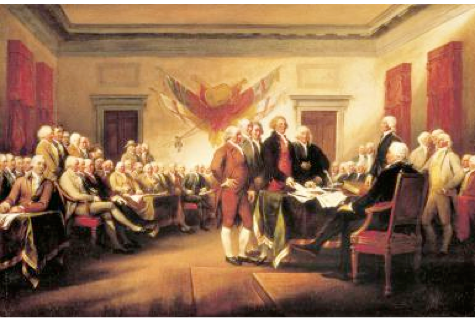Lesson 2: Defining Diversity through History
Attention

The Founding Fathers presenting their draft of the Declaration of Independence to Congress, June 28, 1776, by John Trumbull 1819.
Photo: DEA Picture Library/Getty Images
Learning Outcomes
Upon completion of this lesson's material, students will be able to:
- Analyze historical facts and interpret aspects of enculturation and its effects on respective cultures.
- Discuss cultural diversity and explore why diversity may be beneficial for a society to function.
Teaching
According to an internet search, the 'American Dream' was first publicly defined 155 years after the presentation of the Declaration of Independence. In 1931 James Truslow Adams coined the term & idea in his book: Epic of America. Adam's stated, "The American Dream is that dream of a land in which life should be better and richer and fuller for everyone, with opportunity for each according to ability or achievement."
Adams went on to say that it is not, "... a dream of motor cars and high wages merely, but a dream of social order in which each man and each woman shall be able to attain to the fullest stature of which they are innately capable, and be recognized by others for what they are, regardless of the fortuitous circumstances of birth or position."
Consider the context of these different events:
The founding fathers were white, male, educated, land owners. The declarations made in the Constitution and the statements of Independence extended the ideas of the American Dream, at that time, to just that same demographic- white, male, property-owners. The idea of inalienable rights was so powerful that laws, over time and with heroic self-advocacy and profound movements of social and cultural change, were added to extend rights to slaves, women and to non-property owners. These changes were not quick, not painless.
United States History Timeline - 1800-1900
United States History Timeline - 1900-2000
Consider some of the pivotal events within the 155 years between the presentation of the Constitution and the cultural presentation and definition of the American Dream in 1931. The Great Depression had gripped the nation. The Great War (WWI) had begun to change the idea of gender roles and introduced traumatized soldiers back into a rapidly changing and industrializing nation. Hitler had taken control of Europe. FDR was making a presidential bid. 25% of the work-force was un-employed, and women (with only limited legal protections) had only been voting for less than a decade.
On one level there were vast changes, but on another level cultural rights and social change were slow in taking hold. How do cultures change? All Cultures are inherently predisposed to change and, at the same time, to resist change.
There are dynamic processes operating that encourage the acceptance of new things & ideas while there are others that encourage changeless stability. There seems to be an inherent fear of change, at the same time we are driven to improve, adapt and grow- which requires change.
There are three general sources of influence or pressure that are responsible for both change and resistance to it:
- Forces at work within a society
- Contract between societies
- Changes in the natural environment
Within a society, processes leading to change include invention and culture loss. Inventions may be either technological or ideological. The latter includes such things as the invention of algebra and calculus or the creation of a representative parliament as a replacement for rule by royal decree. Technological inventions include new tools, energy sources, and transportation methods as well as more frivolous and ephemeral things such as style of dress and bodily adornment.
WHAT DO YOU THINK?



Culture loss is an inevitable result of old cultural patterns being replaced by new ones.
Can you think of examples of cultural loss?? What was common knowledge, behavior and habit one hundred years ago? What were the lessons, skills, and values one hundred years ago? What are they now? A century ago, horse care and horse transport, with little exception, was common knowledge. Since then, vehicles with internal combustion engines have replaced horses, interstate infrastructure has been built, and GPS guidance systems exists. How might that change culture?
Within a society, processes that result in the resistance to change include habit and the integration of culture traits. Older people, in particular, can be reticent to replace their comfortable, long familiar cultural patterns. Do you have a family member that you can identify? The family member that may be described with the following statements: "Don't mind Grandma, she's stuck in her ways" or "Grandpa doesn't get it, and just doesn't want to"?? Habitual behavior provides emotional security in a threatening world of change. Do you have habits that reinforce your own emotional security in chaos or through the threats of change?
The processes leading to change that occur as a result of contact between societies are:
- Diffusion
- Acculturation
- Transculturation
- Assimilation
- Ethnocentrism
- Xeonocentrism
Diffusion is the movement of things and ideas from one culture to another. When diffusion occurs, the form of a trait may move from one society to another but not its original cultural meaning.
Acculturation is what happens to an entire culture when alien traits diffuse in on a large scale and substantially replace traditional cultural patterns.
While acculturation is what happens to an entire culture when alien traits overwhelm it, transculturation is what happens to an individual when he or she moves to another society and adopts its culture. (Ex. Immigrants who successfully learn the language and accept as their own the cultural patterns of their adopted country have transculturated. In contrast, people who live as socially isolated expatriates in a foreign land for years without desiring or expecting to become assimilated participants in the host culture are not transculturating).
Assimilation is the absorption of an individual or minority group of people into another society or group. This is achieved by learning and adopting the cultural traditions of the society to which assimilation occurs. It is also often hastened by intermarriage and by de-emphasizing cultural and or biological difference
There is one last process leading to change that occurs as an invention within a society as a result of an idea that diffuses from another. This is stimulus diffusion --a genuine invention that is sparked by an idea from another culture.
There are processes operating in the contact between cultures as well that result in resistance to change. These are due to "us versus them" competitive feelings and perceptions.
Pink Floyd - Us and Them
Click HERE to view this directly on YouTube
Ethnocentrism is the feeling that your own group's cultural traditions and values are correct and superior to all others. This is usually coupled with a generalized dislike and even contempt for people who have other cultural traditions.
Ethnocentrism also leads people to reject alien ideas and things as being unnatural and even immoral.
Xenocentrism is the tendency to value commodities, style, culture, and even ideas from another country or culture other than your own as better.
These ingroup-outgroup dynamics commonly result in resistance to acculturation and assimilation.
Summary: In order to better grasp the relationship between all of the different mechanisms of change operating within and between societies, it is useful to conceptualize them in this way:

Copyright © 1997-2006 by Dennis O'Neil.
What is Cultural Diversity?
Definition: Cultural diversity is when differences in race, ethnicity, language, nationality, religion, and sexual orientation are represented within a community. A community is said to be culturally diverse if its residents include members of different groups. The community can be a country, region or city and research supports that schools and colleges, workplaces and other collections of individuals can share features of community.
Why does cultural diversity matter?
People from different races, ages, genders, ethnicities, sexual orientations, sub-cultures and with different diagnoses/disabilities and/or who have different experiences, etc. have different perspectives. Their unique backgrounds flavor their interpretation of events. These differences can bring strength to the group if it is valued and integrated into the group dynamics. It can take time, planning and the willingness to be open-minded and non-judgmental about the value the differences bring. It takes intentionality and effort to make cultural diversity a strength.
Cultural diversity can also weaken a group. Differences in interpretation of events can lead to miscommunication, awkwardness and hostilities if not addressed. Prejudices about people of different backgrounds can also lead people to jump to conclusions and misinterpret actions and behaviors. Can you give some examples?
Legal protections pertaining to the workplace: Equal Employment Opportunity (EEO) laws help to ensure that race, sex, national origin, and other legally protected characteristics are not considered in employment decisions. EEO is derived from federal, state and local laws that govern all employment-related actions. Affirmative action regulations can help to identify and remove barriers to the hiring and the advancement of minorities, women, individuals with disabilities, and veterans. Others have questioned the fairness of these affirmative action policies.
The U.S. Equal Employment Opportunity Commission is responsible for enforcing federal laws that make it illegal to discriminate against a job applicant or an employee because of the person's race, color, religion, sex (including pregnancy), national origin, age (40 or older), disability or genetic information.
Ted.com: How to Overcome our biases? Walk boldly toward them
Ted.com: Color blind or color brave?
Labor Force Statistics from the Current Population Survey
Assessment
In this section you will find a list of the required Assessments that accompany this Lesson. The Lesson Discussions are designed for the ONLINE and HYBRID versions of this course. If you are not in an ONLINE or HYBRID version of this course you can ignore these instructions unless otherwise guided by your instructor.
Lesson 2 Quiz
Define and give examples of each term below using the US History Timelines embedded within the lesson. If you are unable to identify each term within the timeline, research events of US History to provide examples.
1. Diffusion
2. Acculturation
3. Transculturation
4. Assimilation
5. Ethnocentricism
6. Xenocentricism
Lesson 2 Discussion A
Watch each ted.com talk within the lesson and write a summary of the talk, along with your thoughts, feelings and opinions regarding the content of each talk. This should be at least five sentences- an introduction, three observations and a concluding sentence. Elaborate, as necessary
Lesson 2 Discussion B
Consider the following resource (Labor Force Statistics from the Current Population Survey) and the definition of cultural diversity and give specific examples of why cultural diversity matters. Again, your answer should be at least five sentences long- introduction, three supporting observation, and conclusion.